The oranda, known in Japanese as 和蘭獅子頭, is a popular ornamental goldfish species (carassius gibelio forma auratus) commonly kept in home aquariums. Distinct from veiltail varieties, the oranda features fleshy growths on its head and gill covers, most notably its “hood,” or ‘wen.’ This hood typically begins to develop around three to four months of age but reaches full maturity only after one to two years. While the hood can be considered fully developed by about 2 to 2.5 years, careful attention to water quality and diet can enhance its growth and overall health.

Contents
Habitat in the wild
The oranda goldfish is a popular and visually striking variety of goldfish renowned for its unique appearance. This ornamental fish belongs to the family Cyprinidae, which includes other freshwater species like carp and minnows. Selective breeding over centuries has produced an impressive range of shapes, colors, and patterns, with the oranda being a standout.
Originating from wild cyprinoid fish that inhabited Asia, orandas thrive in slow-moving waters such as rivers, ponds, and lakes. Their history traces back to ancient China, where goldfish were domesticated over a thousand years ago. The oranda specifically is believed to have emerged during the Ming Dynasty in the 1500s, likely resulting from the crossbreeding of the Chinese “Wakin” goldfish and the “Ryukin,” which was introduced from Japan. The Wakin contributed the long, single tail, while the Ryukin added the distinctive hump or “wen” on the head.
The term “Oranda” derives from the Japanese word “oran,” meaning “Dutch,” reflecting the exotic appeal of the Dutch during Japan’s early interactions with this goldfish variety. Despite its Japanese name, the oranda’s development largely occurred in China.
In the 18th century, oranda goldfish made their way to Japan, where selective breeding efforts intensified, enhancing their unique traits, especially the size and shape of the wen. Japanese breeders established strict standards for goldfish varieties, contributing significantly to their refinement.
From Japan, orandas spread globally through trade and exploration, gaining popularity in Europe and North America during the 19th and 20th centuries as ornamental fish. Continued selective breeding has resulted in the diverse colors and patterns seen in modern oranda goldfish.
Today, oranda goldfish remain a favorite among fish enthusiasts for their striking looks and distinctive head growth. The dedication of breeders over generations ensures that these beautiful fish are widely available to hobbyists around the world, captivating new and experienced aquarists alike.
Description
One of the most distinctive features of the oranda is the fleshy tissue on the top of its head, known as the “wen” or “crown.” This growth begins to develop when the fish is young and continues to grow as it matures. The size and shape of the wen can vary significantly among individual fish, and it may sometimes partially or completely cover their eyes.
Size
Oranda goldfish typically grow to a size of about 8 to 12 inches (20 to 30 centimeters) in length, although they can reach larger sizes if kept in spacious environments. Individual growth can vary, with some fish exceeding this average range while others remain smaller. Notably, females often grow slightly larger than males, particularly when carrying eggs during the breeding season.
Lifespan
Oranda goldfish typically have a lifespan of 10 to 15 years when provided with optimal tank or open water conditions. With dedicated care and a healthy environment, they can occasionally live even longer, reaching up to 20 years or more.
Body
Oranda goldfish feature a rounded, egg-shaped body with a gently arched back, giving them an attractive appearance. Their large, oviform body is adorned with shiny scales, and they possess claw-ended paired veiltail fins that fan out gracefully when the fish stops swimming and hovers. The remaining fins, except for the dorsal fin, also have claw-ended shapes. Additionally, the head and gill covers are embellished with fleshy outgrowths that develop as the fish matures, adding to their distinctive charm. These striking features make oranda goldfish a popular choice among aquarium enthusiasts.
Color
Oranda goldfish come in a wide range of colors, including red, orange, white, black, blue, chocolate, and various calico patterns, where the body is covered in bright spots of mixed colors.
| Characteristic | Description |
|---|---|
| Body Shape | Egg-shaped body with a dorsal fin and paired anal fins |
| Tail Shape | Long, flowing, single tail (without a fork) |
| Head Growth (Wen) | Fleshy outgrowth on the head, covering the skull |
| Color Variations | Various colors including red, orange, white, black, etc. |
| Size | Can grow up to 8-12 inches (20-30 cm) in length |
| Lifespan | Average 10-15 years with proper care |
| Temperament | Peaceful and social, can be kept in a community tank |
| Diet | Omnivorous, eats fish flakes, pellets, vegetables, etc. |
| Tank Size | Requires a spacious aquarium or pond |
| Water Temperature | 65-72°F (18-22°C) |
| Water pH | 7.0-8.4 |
| Water Hardness | Soft to moderately hard |
| Water Quality | Requires good filtration and regular water changes |
| Breeding | Egg-layers, breeding requires specific conditions |
| Difficulty of Care | Moderate, need attention to water quality and diet |
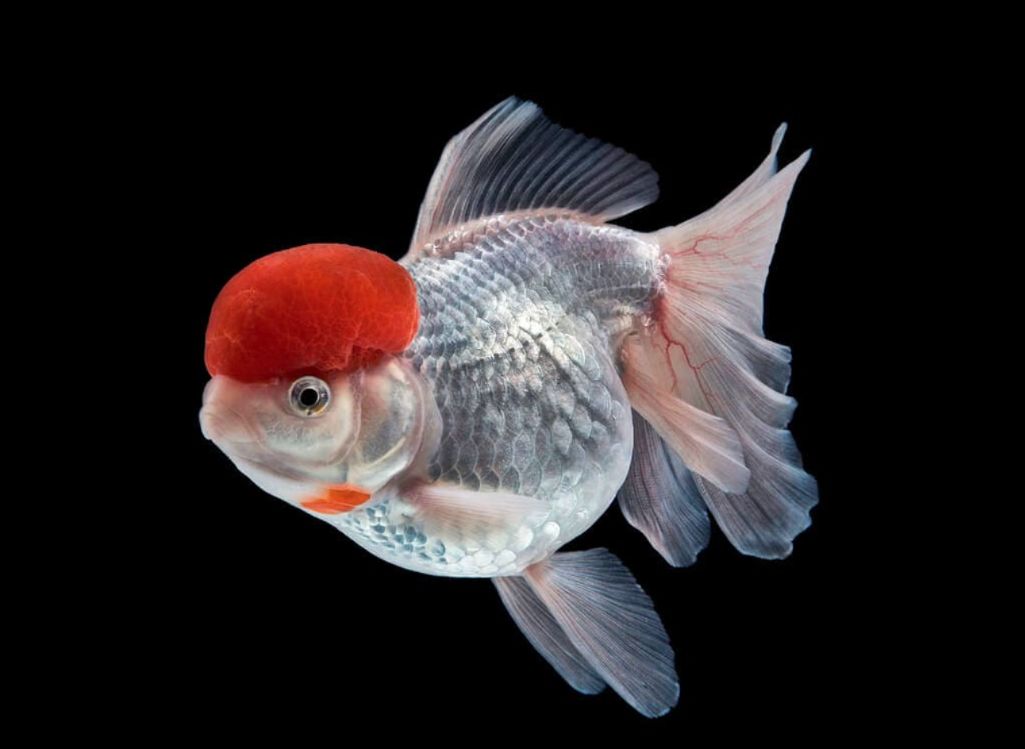
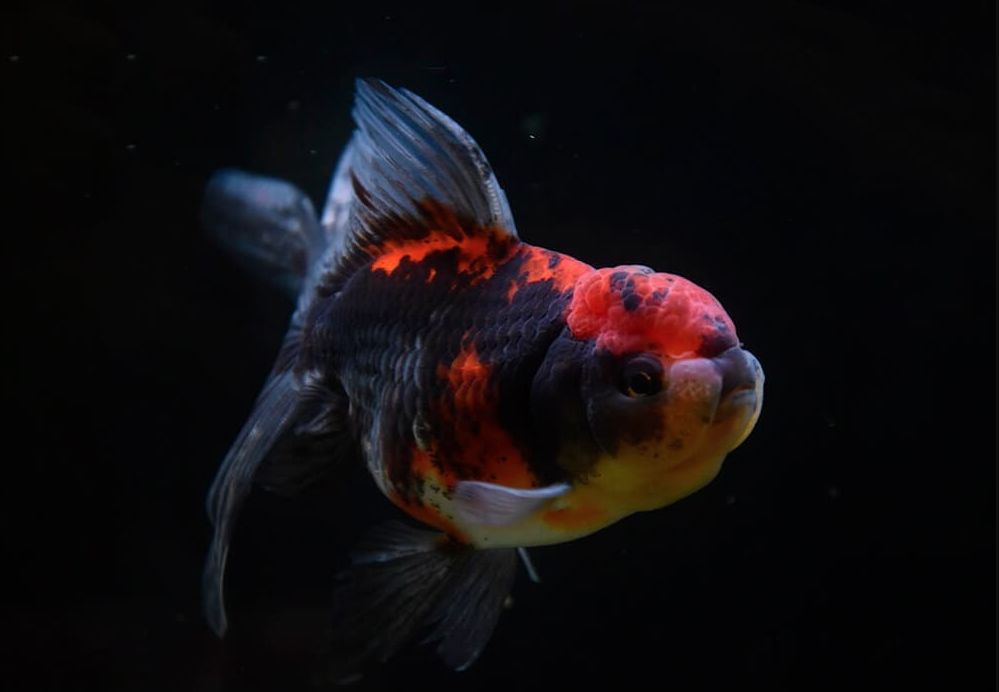
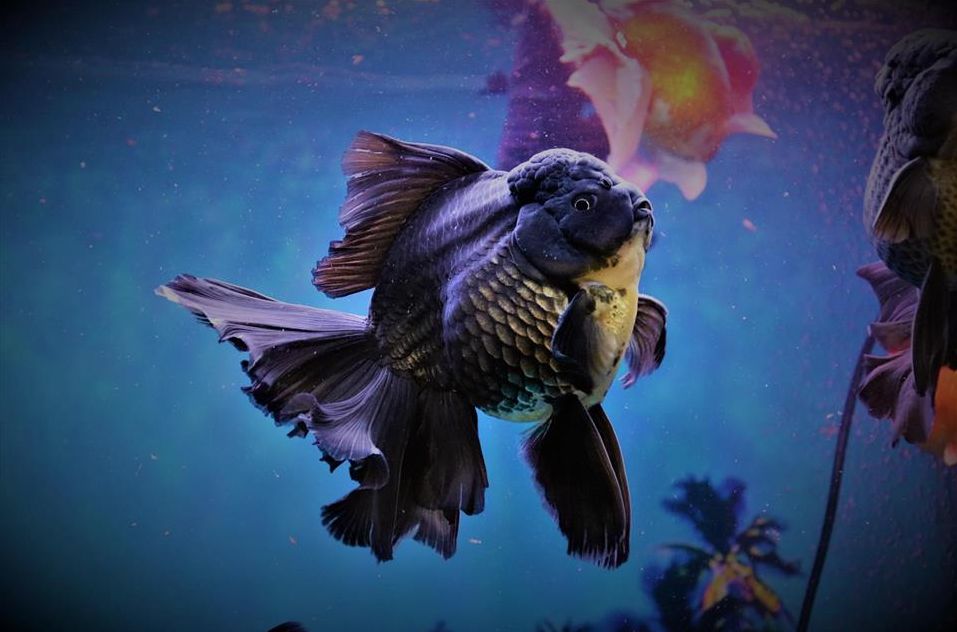
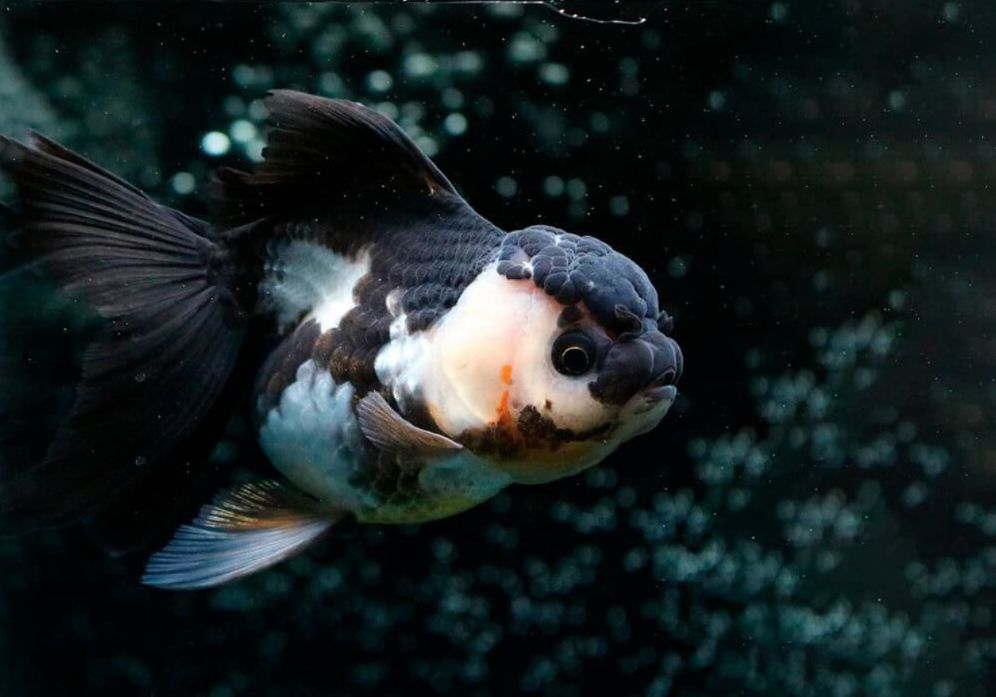
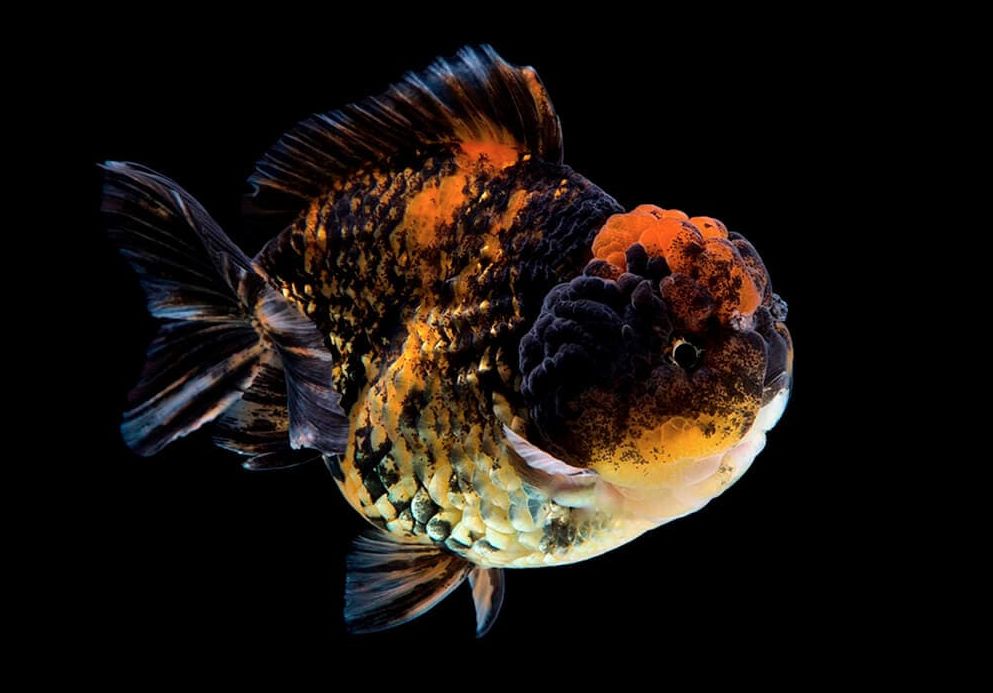

Difficulties in keeping
Oranda goldfish are generally undemanding, as they are descendants of common carp that thrive in colder waters. While these fish are often found in open waters with lower temperatures than tropical species, they are also adaptable in terms of diet, making them easy to feed. However, despite their hardiness, oranda goldfish require gentle care, which may not make them ideal for beginner aquarists.
Unlike their flat-bodied relatives, such as ordinary goldfish and comet fish, oranda goldfish are sensitive to water quality and do not tolerate poor conditions well.
Care and keeping in a tank
Oranda goldfish is one of the most demanding species among all the goldfish, so it’s not recommend for beginner aquarists to keep. The oranda goldfish is very sensitive to water contamination, its ‘hood’ is prone to various infections, bacteria and fungi, if the water is very dirty. The fish needs a lot of free space and proper care.
Tank size
The tank should be spacious and rectangular, providing a large surface area for swimming. While a smaller tank of 40 liters (about 8.8 gallons) may suffice for a small fish initially, oranda goldfish require ample space to thrive as they grow.
To start, it’s recommended to get a tank with a capacity of at least 30 gallons (approximately 113 liters) for one oranda goldfish. For each additional fish, increase the tank volume by 10 to 20 gallons (38 to 76 liters). A larger tank not only allows for more swimming space but also helps dilute waste, reducing the frequency of water changes.
Having a larger volume of water ensures better water quality, minimizes contamination from the fish’s waste, and provides adequate oxygen levels for your pets. T
Water parameters
Here are the recommended conditions for keeping these beautiful fish in an aquarium:
Temperature: 18-22°C (65-72°F)
Oranda goldfish prefer slightly cooler temperatures but are sensitive to very low conditions. It’s advisable not to drop the water temperature below 16°C (60°F) in their tank.
pH Level: 7.0-8.0
These fish can tolerate a range of pH levels, but slightly alkaline water is ideal for their health.
Ammonia and Nitrite: 0 ppm
Both ammonia and nitrite are highly toxic to fish, and levels must be maintained at zero. Regular testing is crucial to ensure safety.
Nitrate: Below 40 ppm (ideally lower)
Nitrate, a byproduct of the nitrogen cycle, should be minimized through regular partial water changes. Elevated levels can stress fish and harm their health.
General Hardness (GH) and Carbonate Hardness (KH): Moderate to moderately hard
Oranda goldfish can adapt to various water hardness levels, but moderate hardness is generally best for their well-being.
Stability in water parameters is crucial; sudden fluctuations can lead to stress and health issues. To maintain optimal conditions, regularly use a reliable water testing kit to monitor ammonia, nitrite, nitrate, pH, GH, and KH levels.
Perform partial water changes of about 25-30% of the tank volume weekly, or more frequently if the tank is overcrowded. Investing in a quality canister filter is essential to remove waste and maintain clarity, with biological filtration to support a healthy environment.
Additionally, avoid overfeeding, as leftover food can lead to increased ammonia levels.
Substrate
The choice of substrate is important for the health and comfort of oranda goldfish. The tank bottom should ideally be covered with smooth gravel that won’t harm the fish, as orandas enjoy digging. When using gravel, opt for larger particles (around 3 to 5 mm) to prevent accidental ingestion during foraging.
Some aquarists prefer smooth river rocks as a substrate. Ensure that the rocks are sufficiently large to avoid accidental swallowing by the goldfish, providing both safety and an attractive appearance.
In certain situations, such as quarantine tanks or when maintaining cleanliness is a challenge, keeping the tank bottom bare is a viable option. A bare-bottom tank simplifies cleaning and reduces the risk of debris buildup, making it easier to maintain a healthy environment for your oranda goldfish.
Tank decor
When decorating your oranda goldfish tank, it’s important to choose items carefully to ensure the safety of your fish. Avoid decorations with sharp edges, as they can harm the fish’s fins or fleshy outgrowths. Opt for smooth stones and driftwood to create a safe environment.
You can include both live and artificial plants in the tank, but if you choose live plants, they should have strong roots and coarse leaves. Oranda goldfish enjoy foraging, so plants that are easily eaten should be avoided. Suitable choices include hardy plants like anubias, which have tough leaves and will contribute positively to the tank environment without being consumed.
While oranda goldfish are not prone to jumping, using a cover glass or lid is advisable to minimize water evaporation.
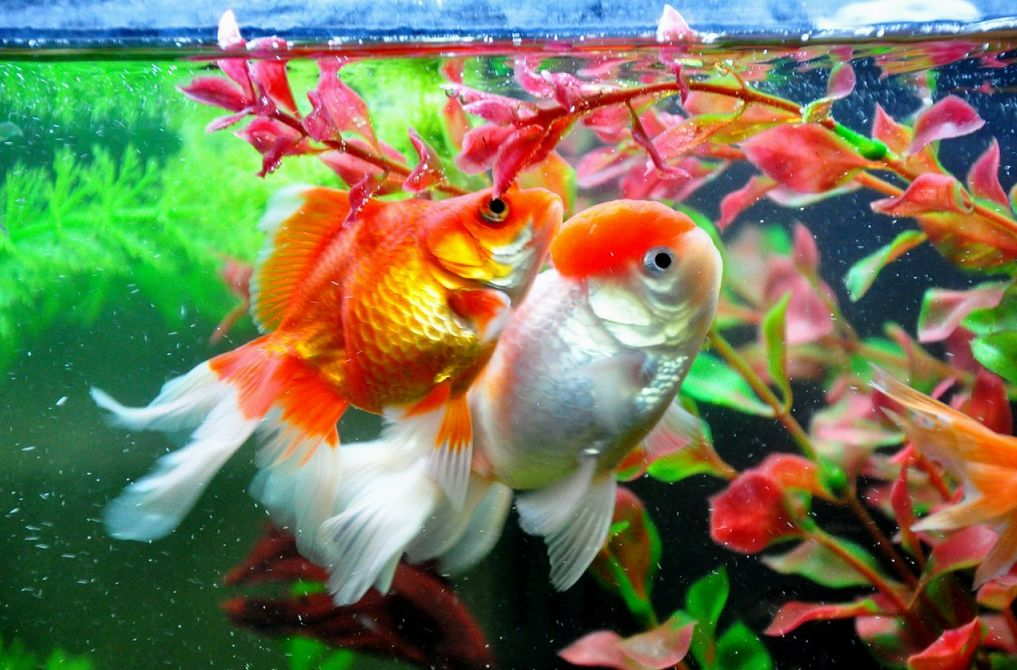
Tank mates
When selecting tank mates for oranda goldfish, it’s crucial to consider their peaceful temperament and slow-moving nature. Orandas thrive best in the company of other calm, slow-moving fish that can tolerate similar water conditions.
Suitable Tank Mates:
- Other Goldfish: The best companions for oranda goldfish are other fancy goldfish varieties, such as ryukins, fantails, ranchus, or even other orandas. Ensure your tank is large enough to comfortably house multiple goldfish, as they can grow significantly. Avoid pairing them with fast swimmers like common goldfish or shubunkins, as orandas are not particularly agile.
- Bristlenose Plecos: These peaceful, algae-eating catfish help keep the tank clean. Just make sure there’s enough space, as they can grow to about 5-6 inches (12-15 centimeters).
- Corydoras Catfish: These bottom-dwelling catfish are peaceful and add activity to the lower regions of the tank.
Important Considerations:
Regularly monitor the tank environment to ensure all fish are coexisting peacefully and that there are no signs of aggression or stress.
Avoid aggressive or fin-nipping fish, such as tiger barbs, as they may harass orandas, which are slower and have longer fins.
Be mindful of fish that might outcompete orandas for food. Due to their head growth (wen), orandas may be slower eaters, so ensure they receive ample food.
Provide an adequately sized tank to accommodate all fish comfortably; overcrowding can lead to stress and health issues.
Diet
As omnivores, orandas consume both plant matter and small aquatic creatures, making variety crucial in their diet.
Key Components of an Ideal Diet:
- Commercial Goldfish Pellets: High-quality pellets should be the staple of their diet. Choose formulas specifically made for goldfish, rich in essential nutrients and vitamins. Pellets that sink slowly are preferred, as orandas often feed at the bottom.
- Live or Frozen Foods: Occasionally offer live or frozen treats to mimic their natural diet. Options like brine shrimp, daphnia, and tubifex are excellent choices. Use these as occasional treats rather than the primary diet.
- Fresh Vegetables: Vegetables play a vital role in their digestive health. Orandas can suffer from digestive issues, so incorporating fiber-rich foods is essential. Offer blanched or boiled peas (with skins removed), zucchini, spinach, lettuce, and cucumber, all chopped into small, manageable pieces.
- Spirulina or Algae-Based Foods: Spirulina-based flakes or pellets are beneficial, as they provide essential nutrients and enhance the fish’s vibrant colors.
Avoid Overfeeding: Goldfish can easily overeat, leading to health problems. Feed small portions multiple times a day instead of one large meal, ensuring they consume everything within a few minutes. Remove any uneaten food to maintain water quality.
Gender differences: male vs female
Determining the sex of adult oranda goldfish can be challenging, particularly outside the breeding season when external differences are subtle. However, there are a few characteristics that can help distinguish between males and females:
Body Shape: Generally, females appear rounder or more full-bodied, especially when carrying eggs. This difference can be subtle and may not always be a reliable indicator.
Vent Position: The vent, located near the anal fin, tends to be larger and more rounded in mature females compared to males, whose vents are smaller and more pointed. Differentiating based on vent position may require some experience.
Breeding Tubercles: During the breeding season, males often develop small white bumps called breeding tubercles on their gill covers and pectoral fins. These tubercles stimulate females during spawning, but not all males develop them prominently, and some females may have tiny tubercles as well.
Behavior: Males may display more territorial or aggressive behavior during breeding season, which can provide clues to their sex. Observing interactions, such as males chasing females, can also offer insights.
For accurate sexing, consider combining these methods, especially during the breeding season when some traits become more pronounced.
Breeding
Breeding oranda goldfish is relatively straightforward, though achieving high-quality juveniles can be more challenging. Orandas typically reach reproductive maturity at around 1.5 to 2 years of age. With the arrival of spring and longer days, male orandas become more active, often displaying courtship behaviors to attract females.
Signs of Spawning Readiness: During this time, males develop noticeable white grains on their heads and gill covers, as well as notches on their pectoral fins. It’s common for aquarists to separate males and females before spawning to manage the breeding process more effectively.
Setting Up the Breeding Tank: For breeding, a spawning tank of at least 50 liters is recommended. It’s helpful to place a protective net or a bunch of small-leaved plants in the tank to provide a surface for the eggs to adhere to.
Breeding Process: Introduce one female oranda and 2 to 3 males into the spawning tank. The spawning typically begins early in the morning and can last for several hours, during which the female may lay approximately 2,000 eggs.
Post-Spawning Care: After about two days, the eggs will hatch into larvae. By the fifth day, the juveniles begin to swim freely. During this initial stage, it’s important to feed the young fish with small foods such as rotifers and brine shrimp to support their growth and development.